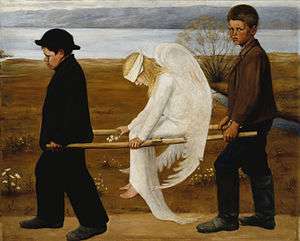Hugo Simberg
| Hugo Simberg | |
|---|---|
 Hugo Simberg in his garden, 1907. | |
| Born |
24 June 1873 Hamina, Grand Duchy of Finland, Russian Empire (now Finland) |
| Died |
12 July 1917 (aged 44) Ähtäri, Grand Duchy of Finland, Russian Republic (now Finland) |
| Nationality | Finnish |
| Known for | Painting |
| Movement | Symbolism |
Hugo Gerhard Simberg (24 June 1873 - 12 July 1917) was a Finnish symbolist painter and graphic artist.
Life and career
Simberg was born on 24 June 1873, at Hamina (original Swedish Fredrikshamn), the son of Colonel Nicolai Simberg and Ebba Matilda Simberg (born Widenius). In 1891, at the age of 18, he enrolled at the Drawing School of the Viipuri Friends of Art, and he also studied at the Drawing School of the Finnish Art Association from 1893 to 1895, but in 1895 he decided to become the private pupil of Akseli Gallen-Kallela at his wilderness studio Kalela in Ruovesi. He studied under Gallen-Kallela for three periods between 1895 and 1897.
In 1896 Simberg went to London, and in 1897 to Paris and Italy. During these years he exhibited several works at the Finnish Artists' autumn exhibitions, including Autumn, Frost, The Devil Playing Music and Aunt Alexandra (1898), which were well received. Critical success led to his being made a member of the Finnish Art Association and to his being appointed to teach at the Drawing School of the Viipuri Friends of Art.
In 1904 he was commissioned to decorate the interior of St John's church in Tampere (now Tampere Cathedral), a project which he carried out with Magnus Enckell between 1904 and 1906.
From 1907 to 1917 he taught at the Drawing School of the Finnish Art Association.
He died at Ahtari on 12 July 1917.
Simberg's paintings emphasize mainly macabre and supernatural topics. A good example is Kuolema kuuntelee (Death Listens), which depicts Death, personified as a skeleton wearing a black coat, listening with a bowed head as a young man plays the violin. In the background is an old woman lying on a bed, pale and apparently sickly. There is a suggestion that Death is there for the old woman, but that he is pausing so the young man, possibly the dying woman's son, can have time to finish his violin playing.

Simberg's famous painting The Wounded Angel, too, is somewhat gloomy, its titular character appearing in the shape of a winged angel with a bandaged head, borne on a stretcher by two somberly dressed boys, one of whom looks toward the viewer with a serious expression. The painting is the best known of the artist's works and is especially famous in Finland. The Finnish symphonic metal band Nightwish released on 11 August 2007 a music video based on this painting, "Amaranth".
Another theme in Simberg's work is pre-pubescent boys. Naked boys carrying wreaths are a motif of his frescoes in the Tampere Cathedral, and one of his early photographs, named Guido, Fish Boy, shows a boy sitting on a rock, looking out to sea.
Some paintings and prints

- Haavoittunut enkeli (The Wounded Angel, 1903)
- Kuolema kuuntelee (1897) (Death Listens)
- Kuoleman puutarha (The Garden of Death, 1896)
- UPM-Kymmene logo, the Griffon (1899)
References
Further reading
- S. Koja, ed. Nordic Dawn: Modernism's Awakening in Finland 1890-1920 [exhibition catalogue] (2005. Prestel)
- Hugo Simberg 1873-1917, ed. A. Olavinen [exhibition catalogue, Ateneum Art Museum, Helsinki] (2000)
- Hugo Simberg 1873-1917. His life & art [CD-rom, Ateneum Art Museum, Helsinki] (2000)
External links
| Wikimedia Commons has media related to Hugo Simberg. |